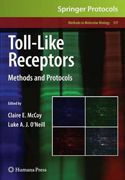
In addition to their invaluable role in the fight against infection, Toll-Like Receptors (TLRs) in an under- or over-active state can lead to the pathogenesis of disease, making these receptors a key focal point for many research laboratories. In Toll-Like Receptors: Methods and Protocols, experts in the fieldcontribute techniques currently used to study TLRs, their downstream signalling pathways, and their role in the pathogenesis of disease, with sections examining TLR expression and the application of genetic techniques and microarray analysis to TLR research. Written in the highly successful Methods in Molecular Biology™ series format, chapters include brief introductions to the topics, lists of the necessary materials and reagents, step-by-step, readily reproducible laboratory protocols, and Notes sections highlighting tips on troubleshooting and avoiding known pitfalls. An easily accessible reference volume for procedures on how to identify, characterize and measure Toll-like receptor expression and downstream signalling Includes step-by-step methods on the most up-to-date techniques such as FRET microscopy, GFP fragmentation, microarray designand analysis and 2D-DIGE comparative proteomics Details the most current disease models used to investigate Toll-like receptor contribution INDICE: From the contents Part I: Methods to Detect and Analyze Toll-Like Receptors. Part II: Methods to Analyze Signal Transduction Downstream of Toll-Like Receptor Stimulation. Part III: Genetic Techniques in Toll-Like Receptor Analysis. Part IV: Toll-Like Receptors and Disease.
- ISBN: 978-1-934115-72-5
- Editorial: Humana
- Encuadernacion: Cartoné
- Páginas: 447
- Fecha Publicación: 01/02/2009
- Nº Volúmenes: 1
- Idioma: Inglés
